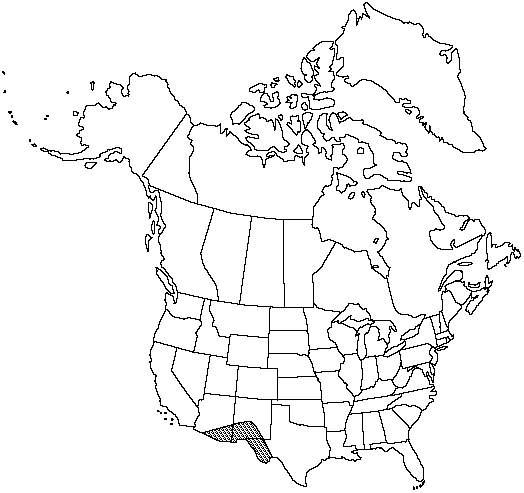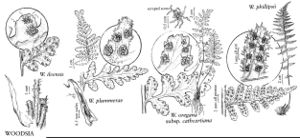Difference between revisions of "Woodsia phillipsii"
Contr. Univ. Michigan Herb. 19: 50. 1993.
FNA>Volume Importer |
FNA>Volume Importer |
||
| Line 17: | Line 17: | ||
}}<!-- | }}<!-- | ||
| − | --><span class="statement" id="st- | + | --><span class="statement" id="st-undefined" data-properties=""><b>Stems </b>compact to short-creeping, erect to horizontal, with few to many persistent petiole bases of unequal lengths; scales mostly uniformly brown but at least some bicolored with dark central stripe and pale brown margins, narrowly lanceolate. <b>Leaves</b> 5–35 × 1.5–6 cm. <b>Petiole</b> light brown or straw-colored when mature, occasionally darker at very base, not articulate above base, relatively brittle and easily shattered. <b>Blade</b> lanceolate, usually 2-pinnate proximally, sparsely to moderately glandular, never viscid; glandular hairs with thin stalks and slightly expanded tips; rachis with scattered glandular hairs and hairlike scales. <b>Pinnae</b> elongate-deltate to elliptic, longer than wide, often attenuate to a narrowly acute apex; largest pinnae with 7–18 pairs of widely spaced pinnules; abaxial and adaxial surfaces somewhat glandular, lacking nonglandular hairs or scales. <b>Pinnules</b> dentate, often shallowly lobed; margins often lustrous adaxially, somewhat thickened, with occasional glands, appearing ciliate due to presence of multicellular translucent projections on teeth that are often prolonged to form twisted filaments. <b>Vein</b> tips usually enlarged to form whitish hydathodes visible adaxially. <b>Indusia</b> of narrow, filamentous segments, these uniseriate for most of length, composed of ± isodiametric cells, often greatly surpassing mature sporangia. <b>Spores</b> averaging 37–44 µm. <b>2n</b> = 76.</span><!-- |
-->{{Treatment/Body | -->{{Treatment/Body | ||
| + | |phenology=Sporulating summer–fall. | ||
|habitat=Cliffs and rocky slopes, usually on granitic or volcanic substrates | |habitat=Cliffs and rocky slopes, usually on granitic or volcanic substrates | ||
|elevation=1600–3200 m | |elevation=1600–3200 m | ||
| Line 39: | Line 40: | ||
|basionyms= | |basionyms= | ||
|family=Dryopteridaceae | |family=Dryopteridaceae | ||
| + | |phenology=Sporulating summer–fall. | ||
|habitat=Cliffs and rocky slopes, usually on granitic or volcanic substrates | |habitat=Cliffs and rocky slopes, usually on granitic or volcanic substrates | ||
|elevation=1600–3200 m | |elevation=1600–3200 m | ||
| Line 46: | Line 48: | ||
|publication year=1993 | |publication year=1993 | ||
|special status= | |special status= | ||
| − | |source xml=https://jpend@bitbucket.org/aafc-mbb/fna- | + | |source xml=https://jpend@bitbucket.org/aafc-mbb/fna-data-curation.git/src/9216fc802291cd3df363fd52122300479582ede7/coarse_grained_fna_xml/V2/V2_61.xml |
|genus=Woodsia | |genus=Woodsia | ||
|species=Woodsia phillipsii | |species=Woodsia phillipsii | ||
| − | |||
| − | |||
| − | |||
| − | |||
| − | |||
| − | |||
| − | |||
| − | |||
| − | |||
| − | |||
| − | |||
| − | |||
| − | |||
| − | |||
| − | |||
| − | |||
| − | |||
| − | |||
| − | |||
| − | |||
| − | |||
| − | |||
| − | |||
| − | |||
| − | |||
| − | |||
| − | |||
| − | |||
| − | |||
| − | |||
| − | |||
| − | |||
| − | |||
| − | |||
| − | |||
| − | |||
| − | |||
| − | |||
| − | |||
| − | |||
| − | |||
| − | |||
| − | |||
| − | |||
| − | |||
| − | |||
| − | |||
| − | |||
| − | |||
| − | |||
}}<!-- | }}<!-- | ||
-->[[Category:Treatment]][[Category:Woodsia]] | -->[[Category:Treatment]][[Category:Woodsia]] | ||
Revision as of 13:24, 27 July 2019
Stems compact to short-creeping, erect to horizontal, with few to many persistent petiole bases of unequal lengths; scales mostly uniformly brown but at least some bicolored with dark central stripe and pale brown margins, narrowly lanceolate. Leaves 5–35 × 1.5–6 cm. Petiole light brown or straw-colored when mature, occasionally darker at very base, not articulate above base, relatively brittle and easily shattered. Blade lanceolate, usually 2-pinnate proximally, sparsely to moderately glandular, never viscid; glandular hairs with thin stalks and slightly expanded tips; rachis with scattered glandular hairs and hairlike scales. Pinnae elongate-deltate to elliptic, longer than wide, often attenuate to a narrowly acute apex; largest pinnae with 7–18 pairs of widely spaced pinnules; abaxial and adaxial surfaces somewhat glandular, lacking nonglandular hairs or scales. Pinnules dentate, often shallowly lobed; margins often lustrous adaxially, somewhat thickened, with occasional glands, appearing ciliate due to presence of multicellular translucent projections on teeth that are often prolonged to form twisted filaments. Vein tips usually enlarged to form whitish hydathodes visible adaxially. Indusia of narrow, filamentous segments, these uniseriate for most of length, composed of ± isodiametric cells, often greatly surpassing mature sporangia. Spores averaging 37–44 µm. 2n = 76.
Phenology: Sporulating summer–fall.
Habitat: Cliffs and rocky slopes, usually on granitic or volcanic substrates
Elevation: 1600–3200 m
Distribution

Ariz., N.Mex., Tex., n Mexico.
Discussion
Woodsia phillipsii traditionally has been identified as W. mexicana. It differs from typical W. mexicana, however, in having completely filamentous indusial segments, multicellular (often filamentous) translucent projections on the pinnule margins, a greater number of pinnules per pinna, and a diploid chromosome number. Woodsia phillipsii is the only diploid species currently recognized in the W. mexicana complex, and it was probably involved in the hybrid origins of both W. mexicana and W. neomexicana. Some individuals of the latter species are difficult to distinguish from W. phillipsii (see comments under W. neomexicana), and the two taxa occasionally hybridize to produce sterile triploids of intermediate morphology. Woodsia phillipsii is also known to hybridize with W. plummerae (see comments under that species) and W. cochisensis.
Selected References
None.
